20 February 2023: Database Analysis
Drug-Induced Cardiotoxicity in Children During the Past 30 Years: A Bibliometric Study and Visualization Analysis
Mingfen Wu1CDE*, Yang Yang2BC, Mingnan Cao1F, Teng Liu1B, Yue Tian1D, Zhigang Zhao1A, Bin Zhu1ACFDOI: 10.12659/MSM.938673
Med Sci Monit 2023; 29:e938673
Abstract
BACKGROUND: Drug-induced cardiotoxicity (DICT) is one of the most serious adverse drug reactions, which is an important safety issue in drug development and clinical practice. This study aimed to summarize the knowledge structure and to detect emerging trends, and provide ideas for future research on DICT in children using bibliometric methods.
MATERIAL AND METHODS: All publications on DICT in children were retrieved through the Web of Science Core Collection up to April 20, 2022. The document type was restricted to articles with the language set to English. CiteSpace and VOSviewer were used to conduct this bibliometric analysis.
RESULTS: A total of 298 articles were included, and the annual publications decreased since 2021. The United States was the leading country with the most publications (117), the highest centrality (0.39), and total citations (4055). The most influential institution was the University of British Columbia, while Carleton BC and Rassekh SR, both from Canada, were the most productive authors, but there was no leader in this field. The keywords with both high frequency and high centrality after excluding “cardiotoxicity” and “children” were acute lymphoblastic leukemia (Freq=43, Central=0.15), childhood cancer (Freq=42, Central=0.13), toxicity (Freq=33, Central=0.16), and breast cancer (Freq=29, Central=0.19). “Adriamycin cardiotoxicity” was the first burst keyword, while “childhood cancer”, “oxidative stress”, and “cardiac dysfunction” were emerging research hotspots.
CONCLUSIONS: Attention to DICT in children was insufficient. This study serves as a breakthrough point, providing a comprehensive overview of the knowledge structure, development landscape, and future opportunities in this field.
Keywords: Adult Children, Bibliometrics, cardiotoxicity, Humans, Child, Female, Breast Neoplasms, Doxorubicin, Drug development
Background
Cardiotoxicity is one of the most serious adverse drug reactions, leading to drug attrition, black box warnings, and post-approval withdrawals [1,2]. The widely accepted definition of cardiotoxicity is a decrease in left ventricular ejection fraction (LVEF) of at least 10% to less than 55% [3]. Drug-induced cardiotoxicity (DICT) refers to the pharmacodynamic response of drugs that affects the physiological function of the heart or damages the myocardium in a relatively small dose and relatively short time [4,5]. Clinical data suggested that drug-induced cardiomyocyte death and mitochondrial toxicity of the heart are the major causes of cardiotoxicity [6,7]. There are also frequent reports of DICT in children, such as antimalarial drugs [8], anti-tumor drugs [9–11], and local anesthesia drugs [12]. Anthracycline-induced cardiotoxicity (ACT) is most commonly reported and is dose-dependent in children. In addition, the age of the patient plays an important role in susceptibility, with younger patients at greater risk for cardiotoxicity and heart failure years after completion of treatment [11]. Cardiotoxic drugs can induce both cardiac dysfunction and myocardial injury [13], and even cause “hidden cardiotoxicity” that manifests only in the diseased heart, such as ischemia/reperfusion injury and/or in the presence of its major comorbidities [5]. The physiology of the heart and the effect of drugs in children vary greatly from adults [14]; therefore, it is crucial to study the cardiotoxic effect of drugs in the pediatric population. In recent years, the number of studies on DICT has increased rapidly, but there is a lack of quantitative analysis and comprehensive evaluation of recent research achievements.
Bibliometrics is a branch of library and information science that evaluates and predicts the research status and development trends of a specific discipline. It enrolls the literature of a discipline as the object and performs quantitative analysis using mathematical and statistical methods [15]. Bibliometric methods have been widely used in medical and health science-related fields such as pharmacovigilance [16], adverse drug reactions [17,18], pharmacy practice research [19], COVID-19 [20], certain drugs [21], and disease treatment [22–24]. The Web of Science Core Collection (WoSCC) is an important database for obtaining global academic information, based on which the metrological characteristics of publications can be analyzed quantitatively and qualitatively.
CiteSpace is a document visualization analysis software based on the Java language runtime platform, invented by Professor Chen Chaomei [25]. It can construct the structure, law, and distribution of related subject knowledge through the method of visualizing information such as document titles, abstracts, keywords, authors, and institutions, revealing the comprehensive research situation and hotspots of a subject or field in a certain period, and can predict development trends in related fields [26]. VOSviewer is also a commonly used visual analysis software of bibliometrics. The advantages of VOSviewer are good graphical presentation ability and bibliographic coupling analysis of literature. In this study, the literature related to DICT was collected and screened from WoSCC. Then, we used CiteSpace 5.8.R3 and VOSviewer 1.6.18 to generate network maps and identify top authors, articles, institutions, countries, keywords, co-cited journals, hotspots, and research trends. The purpose of this study was to reveal the knowledge structure and current status and to detect emerging trends and the main research focus of DICT in children using bibliometric methods. We also aimed to describe in depth the current research foundation and status to provide ideas for future research directions.
Material and Methods
DATA EXTRACTION AND COLLECTION:
To ensure the accuracy of the retrieval, Medical Subject Headings (MeSH) terms and their entry terms in PubMed were combined before the retrieval. Then, we developed a precise formula to retrieve in the SCI-Expanded (Science Citation Index Expanded) of the WoSCC database. To avoid bias caused by database updates, we completed the retrieval within one day, on April 20, 2022. The time was from the database inception to April 20, 2022. All drugs causing cardiotoxicity or cardiotoxic events were included in our study. The cardiotoxicity evaluated in this study included acute myocardial injury and chronic cardiac function impairment. The retrieval strategy was TOPIC: (‘‘drug*’’ OR “medication*”) AND (“cardiotoxicit*” OR “cardiac toxicit*” OR “toxicity, cardiac” OR “cardiac poisonous”) AND (“pediatric*” OR “child*” OR “kid” OR “kids” OR “baby” OR “babies” OR “infant*” OR “toddler*”). Then, we refined the search results by restricting the language to English and the document type to articles. The final 298 articles were included by double manual screening and refining. The literature screening and refining process is shown in Figure 1.
DATA ANALYSIS:
Quantitative analysis of published journals, the number of publications, and citations was performed using Microsoft Excel 2017. We obtained the impact factor and h-index of all publications. The bibliometric analysis was conducted using 2 different visualization software: VOSviewer (Version 1.6.18) and CiteSpace (Version 5.8.R3). Co-citation analysis is a quantitative information research method that mainly studies the relationship between documents by analyzing the situation in which 2 documents are cited simultaneously by other documents. As one of the most important indicators, it has been widely applied in bibliometrics [27]. Co-occurrence analysis is a method that quantifies co-occurrence information in various information carriers, which can reveal the content correlation of information and the association of different items. Citation burst refers to the phenomenon that network data bursts rapidly within a certain period. Through the burst of keywords, the dynamic changes of research hotspots over time can be seen, and the development trend of research can be analyzed. In this study, CiteSpace was used to perform co-occurrence analysis, cluster analysis, and citation burst of keywords, which was helpful to detect the research hotspots and development trends. The importance of network nodes is represented by centrality. Higher centrality represents greater influence. The centralities of the items in this study were calculated using CiteSpace.
Parameter Settings of CiteSpace are as follows: the period was from 1990 to 2022, the time slice was set to 1, and the threshold (Top N) was selected as Top 50, which represented extracting the 50 nodes with the highest frequency every year. In this study, we selected “pathfinder”, “pruning sliced networks”, or “pruning the merged network” in the network clipping functional area parameters to analyze the map, and then adjusted the co-occurrence threshold, displayed frequency threshold, and other parameters to generate the corresponding co-occurrence map.
VOSviewer was used to perform collaborative network analysis on countries, institutions, and authors. The size of the nodes represents the number of publications; a larger size indicated a larger number. The thickness of the line denotes the correlation between 2 items, and a thicker line shows a stronger association. The colors of the nodes indicates distinct clusters or periods.
Results
PUBLICATION OUTPUTS AND TRENDS:
The annual distribution of the publications can reflect the research level and development of a certain discipline and is an important indicator to measure academic research [28]. A total of 298 publications were finally included for analysis. The annual publications and annual citations on DICT from 1990 to 2022 are shown in Figure 2. The first paper was published in 1990, and the most productive year was 2020 with 20 records. The annual outputs did not exceed 10 until 2007 and were between 10 to 20 in the past decade. In terms of the publication years, the number of annual publications and citations increased steadily from 1990 to 2020, but with some fluctuations. The number of publications decreased significantly from 2021, and only 1 article was published in the first quarter of 2022.
There were 9381 cumulative total citations of the 298 articles, including 258 self-citations, by 20 April 2022. The average number of citations was 31.48 and the h-index was 48. The trend of annual citations was similar to that of annual publications. The year with the most citations was 2021, cited 954 times. According to the current data, researchers have not paid enough attention to DICT in children. The annual maximum number of publications did not exceed 20 and declined since 2021. It can be predicted that the number of publications in 2022 would be under 10.
The top 10 most highly cited articles are shown in Table 1. Four of the top 10 articles were published between 2012 to 2015, and the others were published before 2005. The vast majority of the highly cited articles were on the topic of cardiotoxicity induced by anthracyclines in children. The article “Early detection of anthracycline cardiotoxicity and improvement with heart failure therapy” [29] ranked first, with 689 total citations and an annual average of 86.13 citations. It was published in the journal Circulation in 2015. This was a heterogeneous cohort study of 2625 patients receiving anthracycline-containing therapy, which prospectively evaluated the incidence, time of occurrence, clinical correlates, and response to heart failure therapy of cardiotoxicity. Findings showed that most cardiotoxicity following anthracycline-containing therapy occurred within the first year and was related to end-of-treatment anthracycline dose and LVEF. Among the top 10 most highly cited articles, 8 were on the study of ACT, of which 4 were on the related gene prediction of ACT, 3 were on the risk factors of ACT, and 1 article was a monitoring guideline for the ACT. Therefore, it can be speculated that the cardiotoxicity caused by anthracycline anti-tumor drugs has received the most attention and is the current research hotspot.
ANALYSIS OF SUBJECT CATEGORIES, JOURNALS, AND CITED JOURNALS:
According to the content classification of the Web of Science database, 298 articles were spread across 57 specific subject categories. The top 3 subject categories by number of articles were
The division of Journal Citation Report (JCR) is based on the impact factor of journals included in SCI (Science Citation Index). JCR profiles include impact factor (IF), category, ranking, and quartile (Q), which represent a journal’s position and influence in the scholarly communication network. In total, 298 articles in this study were published in 200 journals. The top 10 most productive journals on DICT in children are listed by the number of publications in Table 2. Among the top 10 most productive journals, 6 publishers of these journals were from the United States, 3 were from the UK, and 1 was from Germany. Eight of the top 10 journals belong to the oncology journal category. Pediatric Blood Cancer ranked first in the frequency of the journals (13 records) and H-index ranking (10). Journal of Clinical Oncology ranked first in the IF ranking (IF 50.717), total citations (512 times), and average citations (128 times). Four journals belong to Q1 in the JCR quartile, and more information on DICT in children can be found in these journals.
The top 10 most cited journals with the highest frequency and centrality of DICT in children are listed in Table 3. The most frequently cited journal was the New England Journal of Medicine with 169 citations (IF: 176.079), followed by the Journal of Clinical Oncology (145 citations, IF: 50.717) and Cancer (145 citations, IF: 6.921). In terms of centrality, the American Heart Journal ranked first with a centrality of 0.23, the Annals of Internal Medicine ranked third in centrality with 0.15 and fifth in citation frequency with 88 citations. The top 10 most cited journals with the highest frequency and centrality of DICT in children were all located in the United States and the UK. Taking the above results into consideration, it can be noted that studies on cardiotoxicity in children are mainly concentrated in a few developed countries such as the United States and the UK.
ANALYSIS OF THE PRODUCTIVE COUNTRIES/REGIONS, INSTITUTIONS, AND AUTHORS:
Table 4 lists the top 5 most countries/regions, institutions, and authors on DICT using the country/institution/author co-occurrence network function in CiteSpace, and Figure 3 shows the cooperation networks conducted by using VOSviewer. Studies on DICT in children were conducted in 55 countries, resulting in 70 connections (Figure 3A). The top 5 countries published 218 articles accounting for 73.15%. The United States (117 records) ranked first in the number of publications by an absolute advantage, followed by Canada (28 records) and the Netherlands (25 records). Simultaneously, the United States led the research with the highest centrality of 0.39, an h-index of 34, and total citations of 4055. Canada got the highest average citations of 57.54 among the 55 countries. We found that the influence of the United States was highly prominent, with a centrality of 0.39, followed by the Netherlands, with a centrality of 0.20, which ranked 3rd in the number of publications (Table 4). Figure 3A reveals that there was an absence of academic exchanges between countries with abundant publications and countries with weak publications.
The top 5 institutions published 47 articles accounting for 15.77%. The University of British Columbia ranked first with 12 records. Children’s Hospital got the highest total citation of 1506 and the highest average citation of 136.91 (Table 4). Figure 3B shows that the research of various institutions was relatively scattered, and the degree of cooperation was relatively low and needs to be strengthened.
A total of 1863 authors were filtered out in this study. The top 5 authors published 42 articles, accounting for 14.09% (Table 4). Carleton BC ranked first with 10 published articles, followed by Rassekh SR (9 articles), Lipshultz SE (8 articles), Ross CJD (8 articles), and Hayden MR (7 articles). Two authors, Lipshultz SE from the State University of New York (SUNY) System and Hayden MR from the University of British Columbia, had the highest average citations of 120 and 91.57, respectively, which demonstrated that they have made great achievements in the study of DICT and that their publications were of high academic value. The visualization analysis of the authors’ cooperation in Figure 3C shows that the research group centered on Carleton BC, who was from British Columbia Children Hosp & Res Inst, published a large number of papers and cooperated closely. Only 1 author appeared after using the burst function of CiteSpace, also Carleton BC (burst strength 3.04), and the author’s number research articles on DICT in children increased significantly between 2012 and 2015.
KEYWORD CO-OCCURRENCE NETWORK ANALYSIS:
Research hotspots are scientific issues or topics discussed by a relatively large group of papers that are of common concern to a large number of scholars in a certain field during a certain period [30]. Keywords are the refined expression of research topics and contents of academic papers, and the keyword co-occurrence network can reflect the current research hotspots in a certain field, and which have been produced in the past [27]. Keywords with high centrality represent the status and influence of relevant research content in the research field, while keywords with high frequency represent hot topics in a research field [31]. Through the co-occurrence analysis of keywords by using CiteSpace, a total of 1683 keywords and 12156 connections were obtained in this study. The top 10 high-frequency keywords were: children (76 times), acute lymphoblastic leukemia (43 times), childhood cancer (42 times), cardiotoxicity (41 times), toxicity (33 times), therapy (32 times), breast cancer (29 times), heart failure (26 times), childhood (24 times), and risk factor (23 times). The top 10 high-centrality keywords were: children (0.43), cardiotoxicity (0.26), breast cancer (0.19), toxicity (0.16), acute lymphoblastic leukemia (0.15), childhood cancer (0.13), chemotherapy (0.12), double-blind (0.11), Adriamycin (0.09), and clinical cardiotoxicity (0.09). The top 10 high-frequency and high-centrality keywords indicated that they were the most popular elements (more details are provided in Supplementary Table 1). Figure 4A visualizes the co-occurrence map of keywords by using CiteSpace. Through in-depth analysis of high-frequency and high-centrality keywords, it can be inferred that cardiotoxicity caused by chemotherapy drugs for the diseases of children’s blood-related cancer were research hotspots. Among them, the cardiotoxicity of chemotherapy drugs for the treatment of acute lymphoblastic leukemia was widely studied.
Cluster analysis is an exploratory analysis that can automatically classify sample data to obtain the distribution of the data, which is convenient to observe the characteristics of each cluster’s data [32]. The present study used the LLR (log-likelihood ratio) algorithm in CiteSpace to cluster closely related keywords, assign a value to each cluster, and select the category label with the highest value in the same cluster. A total of 13 clusters were formed in this study, and the clustering modularity Q was 0.5571. Figure 4B shows the visualization of the keywords by using CiteSpace. The cluster named apoptosis was the largest and contained 66 keywords, and the top 5 keywords were apoptosis, oxidative stress, age, DNA damage, and association. More details of the 13 clusters are shown in Supplementary Table 2. The silhouette (S) values of the 13 clusters in our study were all above 0.7, indicating that the results were credible and significant [33]. Before 2000, research was mainly focused on “doxorubicin cardiotoxicity” in cluster 9 and “acute myelogenous leukemia” in cluster 5, whereas “apoptosis” in cluster 0, “multidrug resistance” in cluster 1, “cardiac” in cluster 2, “childhood cancer” in cluster 3, and “intrapleural chemotherapy” in cluster 11 were the major areas of interest after 2008. Interestingly, no new clustering has appeared in the past decade.
ANALYSIS OF KEYWORDS WITH CITATION BURSTS:
Using the keyword burst function of CiteSpace, a total of 13 burst keywords were detected in this study, and the results are shown in Table 5. The burst of high-frequency keywords can be roughly divided into 2 stages in 2012 as the boundary: the first stage was the basic research stage (1992–2012). The frontiers of research during this period focused on the cardiotoxicity induced by doxorubicin in the treatment of childhood cancer, the pharmacokinetics of cardiotoxic drugs, survival in adulthood, and cardiotoxicity induced by tricyclic antidepressants; the second stage was the in-depth research stage (2012–2022). Research hotspots during this period focused on the action mechanism of cardiotoxic drugs, primarily oxidative stress and systemic inflammation, both of which contribute to progressive cardiomyopathy and heart failure [34]. In the most recent 3 years, researchers in the United States have paid great attention to the study of DICT in children.
Discussion
This is the first study to use bibliometrics and visualization information techniques to reveal the development, evolution, and main research focus of pediatric cardiotoxicity. The results of this study show that the number of publications and citations increased generally from 1990 to 2020, but it decreased significantly from 2021. This trend can be explained by the following 3 reasons: Firstly, insufficient attention was paid to DICT in children. The growing number of publications on DICT in adults indicated that attention to the pediatric population was weak. Regarding children as a special group, the development and clinical trials of children’s drugs have always been a problem due to economic, legal, and ethical restrictions, which hinder the study of cardiotoxicity in children. Secondly, advances in genomic analysis and clinical use of tumor immune-targeting agents reduced the use of traditional cardiotoxic chemotherapy drugs, which led researchers to pay less attention to this topic [35]. Thirdly, research stagnation was due to the areas that have been explored over the years. The research focus has always been on the anti-tumor field, and some other drugs that can induce cardiotoxicity have not attracted widespread attention, such as macrolide antibiotics [7], and chloroquine/hydroxychloroquine [36]. Most of them were only case reports or in vitro studies and there has been a lack of in-depth clinical research. Finally, the COVID-19 outbreak changed researchers’ focus and prevented research from going smoothly.
Deep collaborative relationships can establish academic networks, spark innovative ideas and theories, generate new knowledge, and promote the in-depth development of scientific research [37]. The United States was the leading country with an overwhelming advantage in terms of the number of publications, and it was also highly prominent in terms of article quality and influence. Our findings show that the United States had developed small-group cooperation, but there was a lack of cooperation between countries and an absence of academic exchanges between countries with abundant publications and countries with few publications. The same was true for research institutions, with countries just forming their own research teams, and academic collaboration networks have yet to be established. Based on the current situation, exchanges and cooperation among different countries and institutions should be strengthened, and the research results on DICT in different regions and different disciplines should be shared to promote the continuous deepening and progress of research.
The most productive author was BC Carleton from Canada who established a research team and formed close collaboration with others. The main research direction of the author’s research team was the pharmacogenomics study of ACT in children. They assessed these in genotype-guided established risk prediction models and searched for ACT-related gene variants in pediatric cancer patients to identify ACT early [38–42]. These research results can be used to identify high-risk patients who can then be provided with safer treatment options. It is worth noting that although individual authors have made great achievements and personal academic influence, cooperation between highly productive authors was relatively weak, and cooperative relationships among authors were on a small scale, usually occurring between colleagues. Our findings demonstrate that there is no leader in this field yet, which is identical to the findings for countries and institutions. A collaborative academic network is urgently needed to conduct more research on DICT in children and improve the safety of drugs used in children.
The increased number of burst keywords in the citation and the increased frequency of keywords over a certain period were the indicators for evaluating the most cutting-edge themes or emerging trends [30]. We detected that “acute lymphoblastic leukemia” and “childhood cancer” were the most popular keywords, which can be explained by epidemiology and therapeutic drug characteristics. Leukemia is one of the most common pediatric cancers, and acute lymphoblastic leukemia (ALL) is the most common diagnostic pathology in childhood leukemia [14,43]. Anthracyclines have been widely used in children to treat ALL and other cancers, with 50–60% of childhood cancer patients receiving an anthracycline-containing regimen during treatment [44]. Whereas cardiotoxicity as one of the primary adverse effects limited the duration and/or intensity of treatment [45], approximately 65% of anthracycline-treated cancer survivors have evidence of myocardial dysfunction [46]. Although several molecular mechanisms have been proposed, such as oxidative stress, autophagy, mitochondrial damage, apoptosis, ferroptosis, and pyroptosis [47–50], the exact mechanism of ACT remains unclear [11]. Over the years, the molecular mechanisms of DICT, such as oxidative stress response, apoptosis, and protein carbonylation, have been extensively studied. The research trend was a step-by-step progression from clinical studies to mechanisms of action to genetic polymorphisms to predict cardiotoxicity risk. With the widespread clinical use of targeted agents, researchers also noticed their adverse cardiac effects, such as trastuzumab, which has been shown to cause cardiotoxicity in the treatment of breast cancer [51].
As we can see from the overall change tendency of burst keywords, research hotspots have experienced a transition to precision medicine. From 1992 to 2012, the pharmacokinetics of cardiotoxic drugs was the research frontier. At this stage, the researchers studied the pharmacokinetic characteristics of cardiotoxic drugs by monitoring blood-drug concentrations or building mixed-effect models, to reduce or avoid the occurrence of cardiotoxicity by adjusting the administration method according to the drug’s PK/PD (pharmacokinetics and pharmacodynamics) [52,53]. In the following period (2012–2022), the molecular mechanism of DICT in childhood cancer was the research frontier. At this stage, experimental and clinical studies had shown that oxidative stress was the main molecular mechanism of ACT. Investigators continued to conduct intensive studies to elucidate the molecular pathogenesis of ACT to discover new cardioprotective agents against ACT [54]. Although more than a dozen forms of cell death have been discovered to date, the most common forms of cell death in DICT are apoptosis, autophagy, and necrosis [6,55]. Moreover, some new forms of programmed cell death, such as necroptosis, pyroptosis, and ferroptosis, have also been shown to be the pathological mechanism of DICT [56] (Figure 5).
DNA damage and biomarker detection of DICT were the frontiers in recent years. Researchers had carried out many studies from the perspective of genomics to find biomarkers of DICT [57], and genetic testing can help predict an individual’s risk of experiencing ACT [58]. With the continuous deepening of cell molecular biology and the progress of experimental technology, there is increasing emphasis on the early application of biomarkers to detect cardiotoxicity at a stage before it becomes irreversible. Nanoparticles, microRNA, myeloperoxidase, and markers of extracellular matrix turnover have been proven to be more specific relative to troponin and natriuretic peptides for detecting both acute and chronic effects of anthracyclines and other chemotherapy regimens [59]. Different biomarkers have different specificities to cardiotoxicity induced by different drugs; therefore, the use of combinations of biomarkers will be pivotal for future strategies defining the extent of the use of cardioprotective measures. It is speculated that identifying related novel biomarkers and targets of DICT in children will be the research hotspots in the future. Consequently, we can expect more research into these areas in the future, early detection of the potential cardiotoxicity of drugs, guidance on the clinical use of cardiotoxic drugs safely in children, and development of specific cardiac protectants.
The present study has certain limitations. First, we only retrieved and collected publication data from the WoSCC database, and publications in other databases, such as PubMed and Scopus, may not have been included. Moreover, many countries are unable to publish in WOS journals due to financial constraints. Despite the great achievements in research in these countries, their publications are largely unread or are only accessed by limited communities. To fill this gap, another study aimed at systematically analyzing non-SCI papers, such as Chinese papers, is needed to provide a comprehensive overview of papers related to DICT in children from a bibliometric perspective. Second, our study only included articles in English, which may have overlooked some important studies published in other languages. Thirdly, our retrieval time was up to April 20, 2022, due to the constant publication of new papers, and our study could not include more recently published articles. Nonetheless, we believe that the study included the vast majority of publications and that even if some data were omitted, the conclusions of the study are valid.
Conclusions
This study provides a comprehensive overview of the knowledge structure, development landscape, and future opportunities for DICT in children. There has been increasing attention on DICT from 1990 to 2020, but it has declined in the last 2 years. Our results indicate that there was insufficient attention to DICT in the pediatric population. The vast majority of studies have been focused on the cardiotoxicity of chemotherapeutic drugs, especially anthracyclines-induced cardiotoxicity (ACT), which had the most research interest, while concerns about the cardiotoxicity of other drugs have been ignored. The United States was the major contributor both in quality and quantity, but there was a lack of cooperation among countries and an absence of academic exchanges among countries with abundant publications and countries with weak publications. The same was true for research institutions, which just formed their own research teams, and the degree of cooperation was relatively low. DNA damage and biomarker detection of DICT were the frontiers in recent years. More attention to these topics is needed, including pharmacogenomics, apoptosis, DNA damage, oxidative stress, systemic inflammation, and biomarkers, which have great potential to continue to be research hotspots in the near future. The use of combinations of biomarkers will be pivotal for future strategies for defining the extent of use of cardioprotective measures. In conclusion, this study provides a comprehensive bibliometric analysis of DICT in children from a global perspective, and it can serve as a breakthrough point for researchers and policymakers worldwide to identify and contribute to the growing scientific work in this area.
Figures
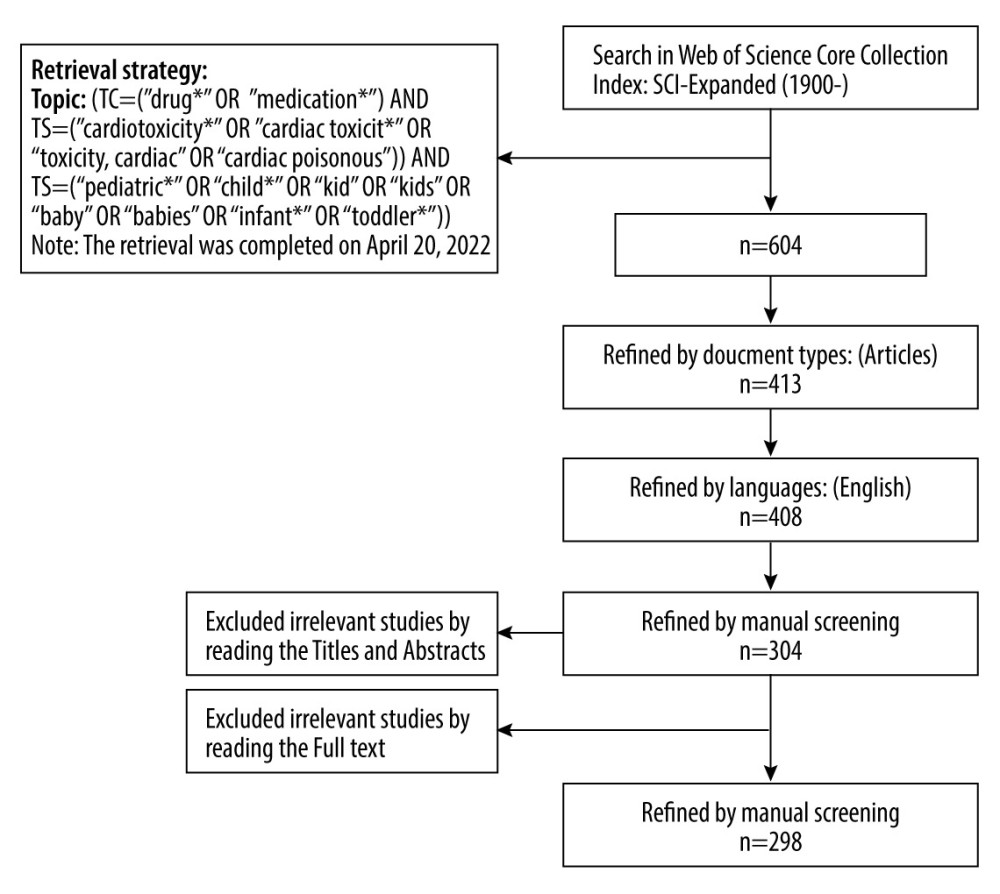 Figure 1. Flow chart of the literature screening and refinement.
Figure 1. Flow chart of the literature screening and refinement.  Figure 2. Annual publications and annual citations on drug cardiotoxicity in children from 1990 to 2022.
Figure 2. Annual publications and annual citations on drug cardiotoxicity in children from 1990 to 2022. 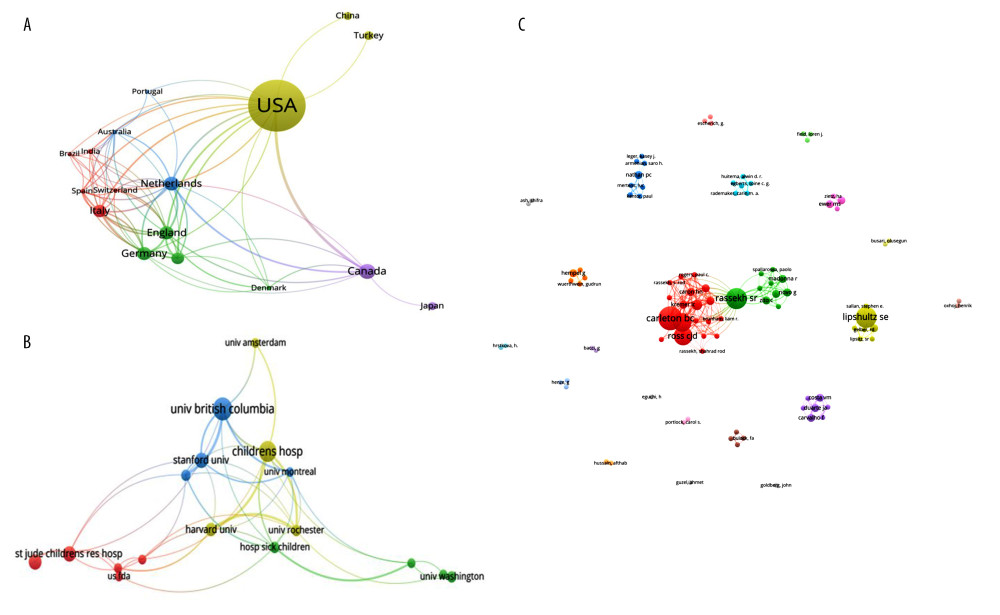 Figure 3. Cooperation among different countries/regions, institutions and authors. (A) Co-occurrence network map of countries/regions. Of the 55 countries, Figure A detailed 17 with more than 5 publications. (B) Co-occurrence network map of institutions. Of the 671 institutions, Figure B shows 18 with more than 5 publications. (C) Co-occurrence network map of authors. Of the 1863 authors, Figure C shows 96 with more than 2 publications.
Figure 3. Cooperation among different countries/regions, institutions and authors. (A) Co-occurrence network map of countries/regions. Of the 55 countries, Figure A detailed 17 with more than 5 publications. (B) Co-occurrence network map of institutions. Of the 671 institutions, Figure B shows 18 with more than 5 publications. (C) Co-occurrence network map of authors. Of the 1863 authors, Figure C shows 96 with more than 2 publications. 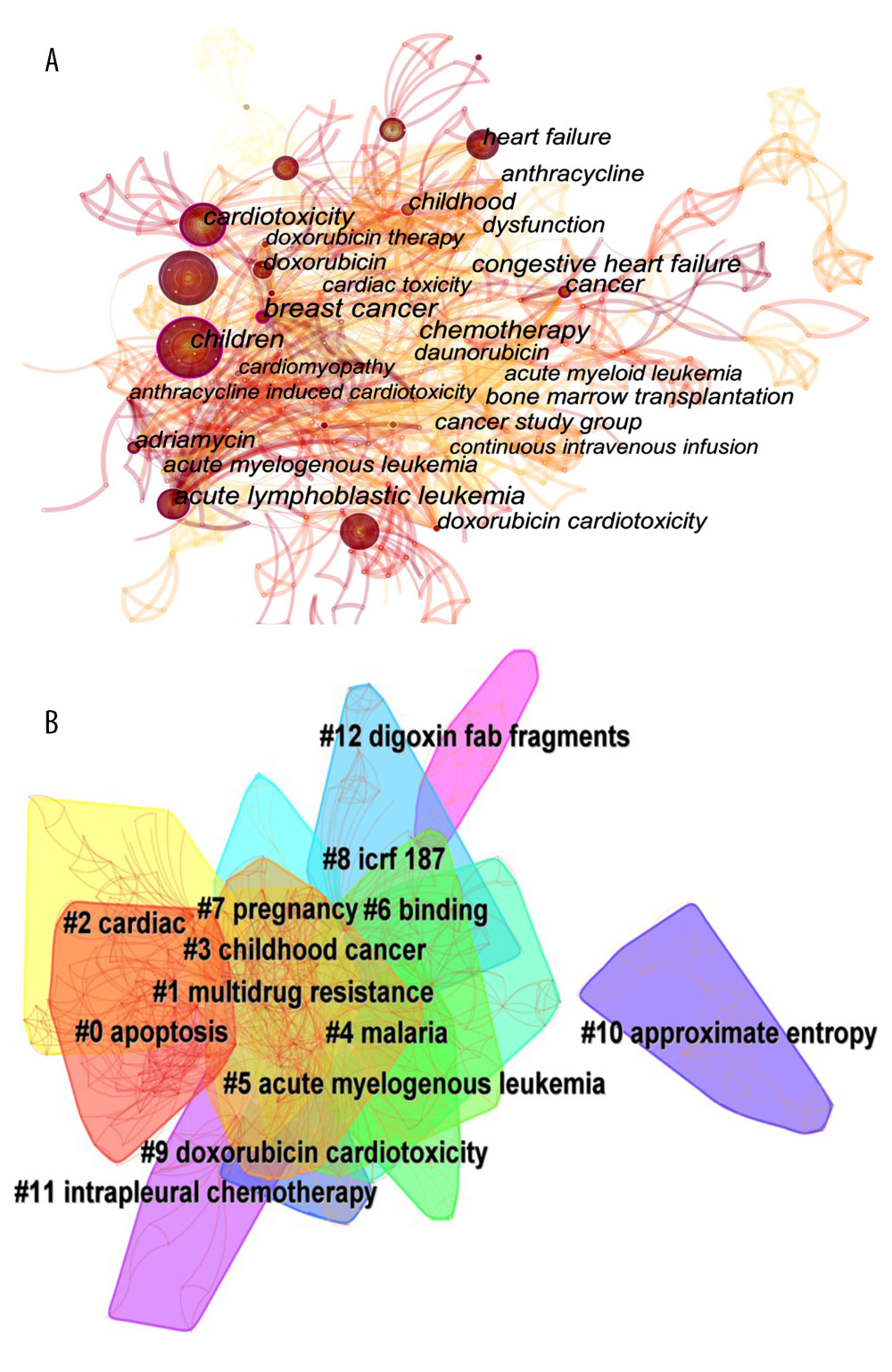 Figure 4. Co-occurrence knowledge graph of the keywords. (A) Visualization analysis of the keywords on drug-induced cardiotoxicity in children. Each circle represents a keyword; the larger the circle, the higher frequency of a keyword. The line between keywords represents the relationship between the 2; the thicker the line, the stronger the relationship. (B) Clusters analysis of the keywords on drug-induced cardiotoxicity in children. Each colored blob represents a cluster. The label number of clusters ranges from 0 to 12; and the smaller the cluster label number, the more keywords the cluster contains.
Figure 4. Co-occurrence knowledge graph of the keywords. (A) Visualization analysis of the keywords on drug-induced cardiotoxicity in children. Each circle represents a keyword; the larger the circle, the higher frequency of a keyword. The line between keywords represents the relationship between the 2; the thicker the line, the stronger the relationship. (B) Clusters analysis of the keywords on drug-induced cardiotoxicity in children. Each colored blob represents a cluster. The label number of clusters ranges from 0 to 12; and the smaller the cluster label number, the more keywords the cluster contains. 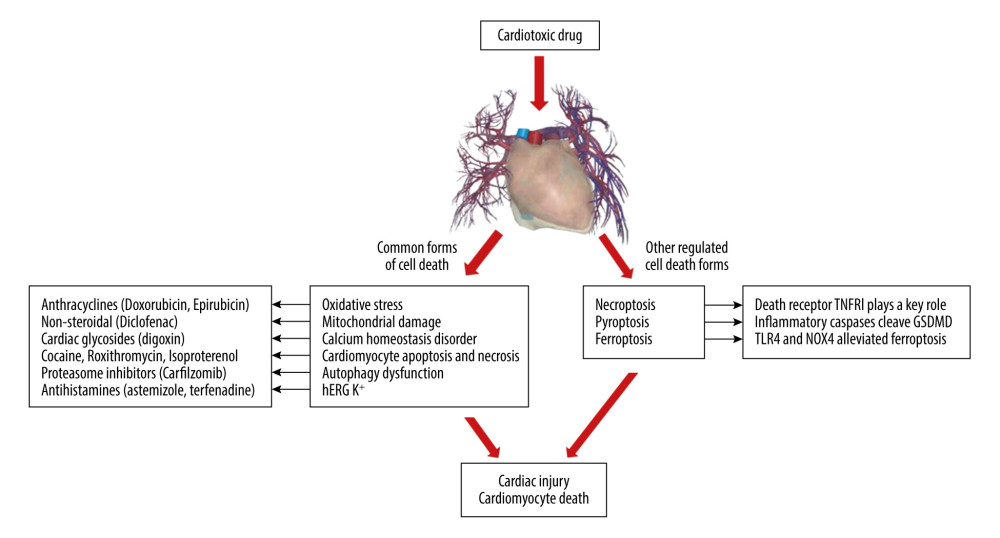 Figure 5. Molecular mechanisms of drug-induced cardiotoxicity.
Figure 5. Molecular mechanisms of drug-induced cardiotoxicity. Tables
Table 1. Top 10 highly cited articles on DICT in children by the number of citations.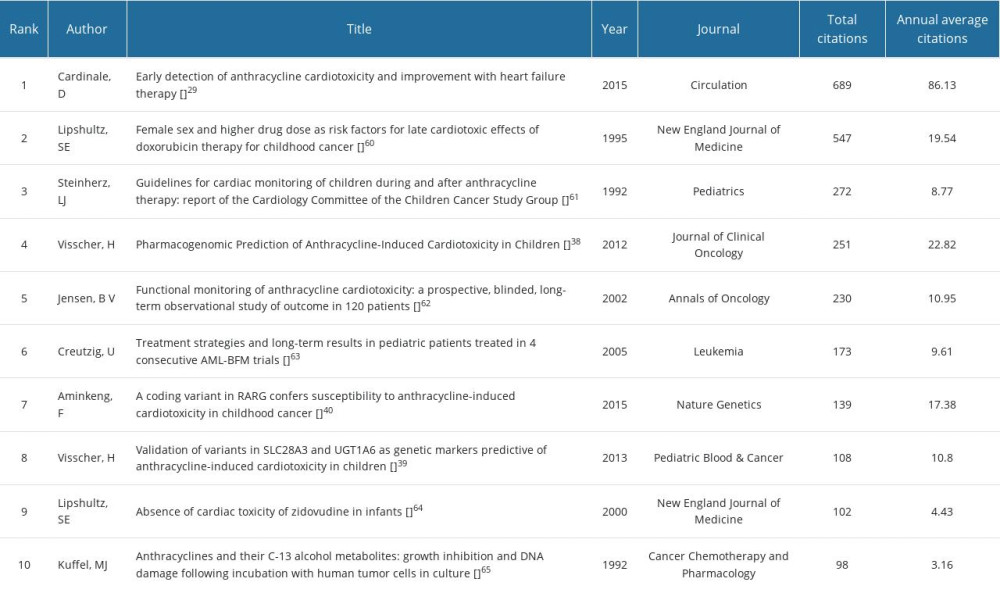 Table 2. Top 10 most productive journals on DICT in children by the number of publications.
Table 2. Top 10 most productive journals on DICT in children by the number of publications.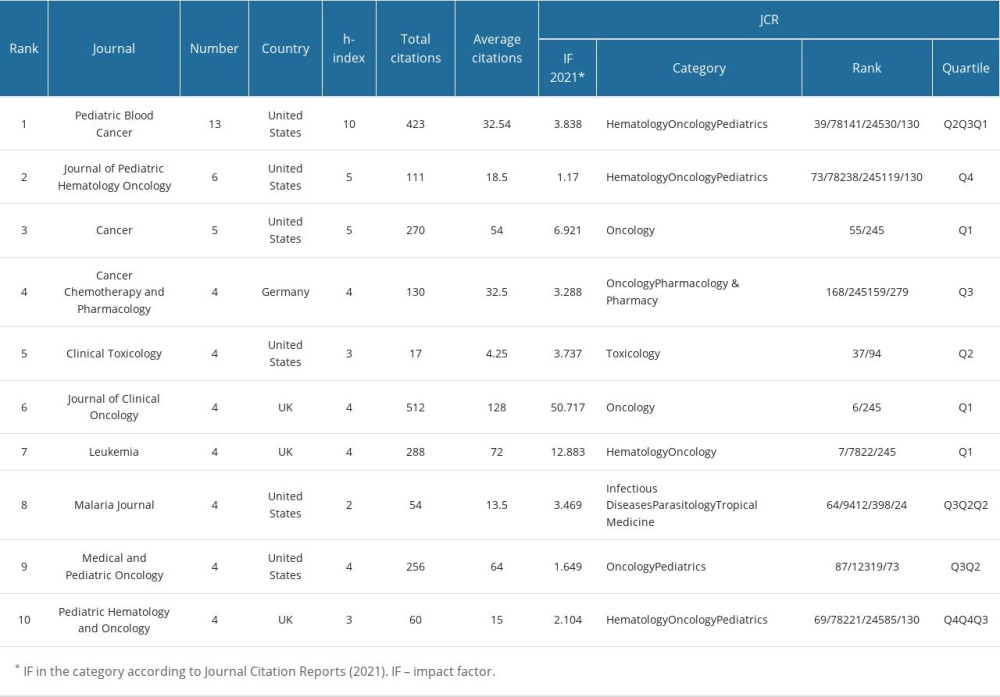 Table 3. The top 10 most cited journals with the highest frequency and centrality of DICT in children.
Table 3. The top 10 most cited journals with the highest frequency and centrality of DICT in children.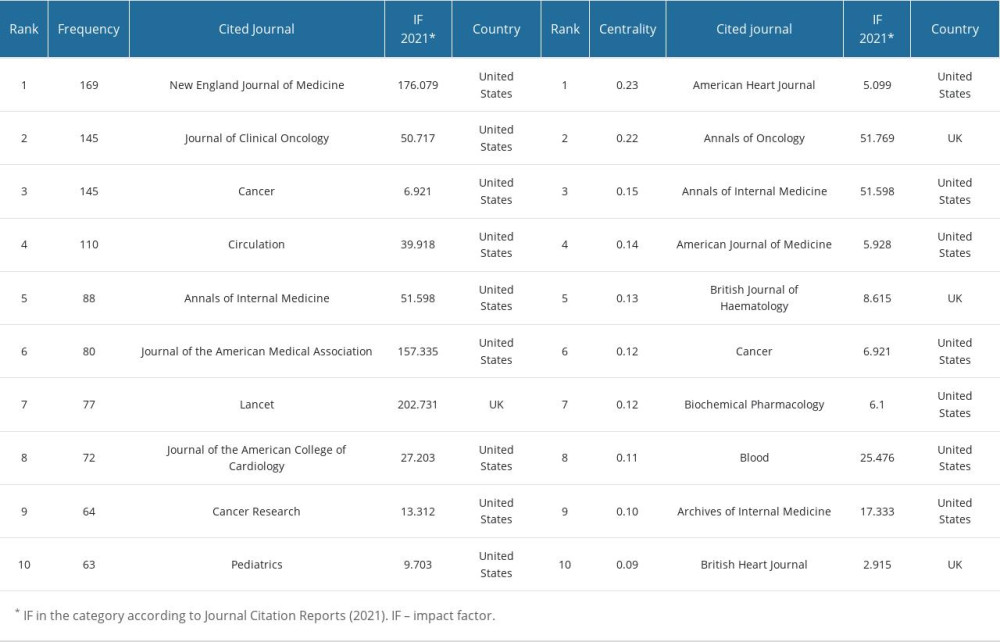 Table 4. Top 5 productive countries/regions, institutions, and authors on DICT in children.
Table 4. Top 5 productive countries/regions, institutions, and authors on DICT in children.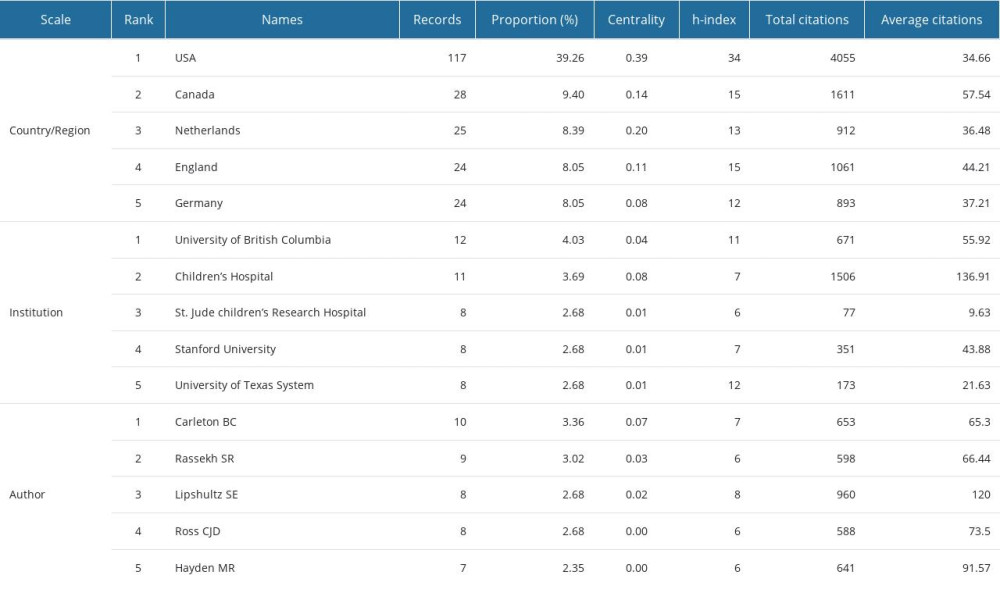 Table 5. Top 13 keywords with the strongest citation bursts on DICT in children.
Table 5. Top 13 keywords with the strongest citation bursts on DICT in children.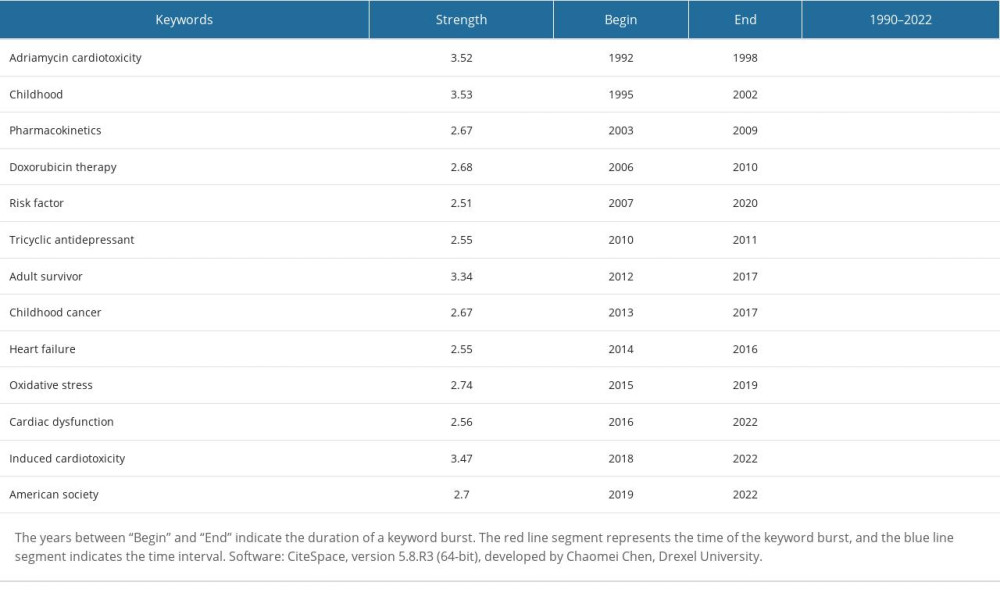 Supplementary Table 1. The top 10 keywords of drug-induced cardiotoxicity in children.
Supplementary Table 1. The top 10 keywords of drug-induced cardiotoxicity in children. Supplementary Table 2. Summary of the largest 13 keywords clusters.
Supplementary Table 2. Summary of the largest 13 keywords clusters.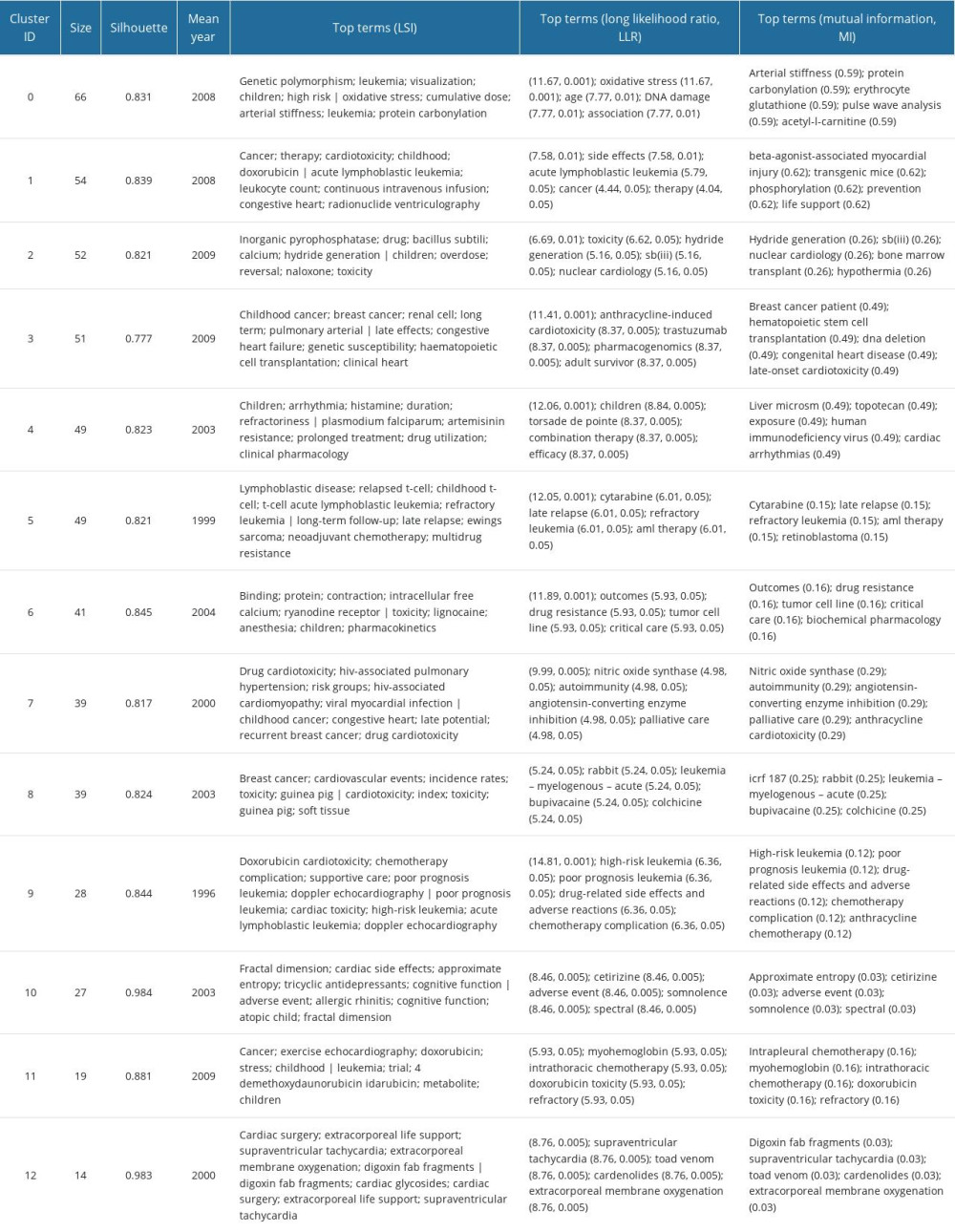
References
1. Onakpoya IJ, Heneghan CJ, Aronson JK, Post-marketing withdrawal of analgesic medications because of adverse drug reactions: A systematic review: Expert Opin Drug Saf, 2018; 17; 63-72
2. Ferri N, Siegl P, Corsini A, Drug attrition during pre-clinical and clinical development: Understanding and managing drug-induced cardiotoxicity: Pharmacol Ther, 2013; 138; 470-84
3. Nicol M, Baudet M, Cohen-Solal A, Subclinical left ventricular dysfunction during chemotherapy: Card Fail Rev, 2019; 5; 31-36
4. Mellor HR, Bell AR, Valentin JP, Roberts RR, Cardiotoxicity associated with targeting kinase pathways in cancer: Toxicol Sci, 2011; 120; 14-32
5. Ferdinandy P, Baczko I, Bencsik P, Definition of hidden drug cardiotoxicity: Paradigm change in cardiac safety testing and its clinical implications: Eur Heart J, 2019; 40; 1771-77
6. Ma W, Wei S, Zhang B, Li W, Molecular mechanisms of cardiomyocyte death in drug-induced cardiotoxicity: Front Cell Dev Biol, 2020; 8; 434
7. Salimi A, Eybagi S, Seydi E, Toxicity of macrolide antibiotics on isolated heart mitochondria: A justification for their cardiotoxic adverse effect: Xenobiotica, 2016; 46; 82-93
8. White NJ, Cardiotoxicity of antimalarial drugs: Lancet Infect Dis, 2007; 7; 549-58
9. Mordente A, Meucci E, Martorana GE, Topoisomerases and anthracyclines: Recent advances and perspectives in anticancer therapy and prevention of cardiotoxicity: Curr Med Chem, 2017; 24; 1607-26
10. Mancilla TR, Iskra B, Aune GJ, Doxorubicin-induced cardiomyopathy in children: Compr Physiol, 2019; 9; 905-31
11. Bhagat A, Kleinerman ES, Anthracycline-induced cardiotoxicity: Causes, mechanisms, and prevention: Adv Exp Med Biol, 2020; 1257; 181-92
12. Faria J, Barbosa J, Leal S, Effective analgesic doses of tramadol or tapentadol induce brain, lung and heart toxicity in Wistar rats: Toxicology, 2017; 385; 38-47
13. Cardinale DM, Zaninotto M, Cipolla CM, Cardiotoxic effects and myocardial injury: The search for a more precise definition of drug cardiotoxicity: Clin Chem Lab Med, 2020; 59; 51-57
14. Hitawala G, Jain E, Castellanos L, Pediatric chemotherapy drugs associated with cardiotoxicity: Cureus, 2021; 13; e19658-69
15. Lutman M, Bibliometric analysis as a measure of scientific output: Br J Audiol, 1992; 26; 323-24
16. Wang L, Feng W, Duan J, Liang J, Pharmacovigilance bibliometrics: Visualizing thematic development in the category of pharmacology and pharmacy in Web of Science: Front Pharmacol, 2021; 12; 731757
17. Cao M, Wang L, Zhang L, Duan J, Global publication trends and hotspots of molecular biomarkers in DILI from 1991 to 2020: A 30-year bibliometric analysis: Sci Prog, 2021; 104; 311971031
18. Zou X, Sun Y, Bibliometrics analysis of the research status and trends of the association between depression and insulin from 2010 to 2020: Front Psychiatry, 2021; 12; 683474
19. Sweileh WM, Contribution of faculties of pharmacy in Arab countries to pharmacy practice research: A bibliometric analysis (1990–2020): Int J Pharm Pract, 2021; 29; 622-32
20. Okhovati M, Arshadi H, COVID-19 research progress: Bibliometrics and visualization analysis: Med J Islam Repub Iran, 2021; 35; 20
21. Song Y, Ma P, Gao Y, A Bibliometrics analysis of metformin development from 1980 to 2019: Front Pharmacol, 2021; 12; 645810
22. Qin Y, Chen S, Zhang Y, A bibliometric analysis of endoscopic sedation research: 2001–2020: Front Med (Lausanne), 2021; 8; 775495
23. Kokol P, Blažun VH, Završnik J, Application of bibliometrics in medicine: A historical bibliometrics analysis: Health Info Libr J, 2021; 38; 125-38
24. Zhang Y, Xu Y, Li S, Bibliometrics analysis of diagnostic test accuracy studies of bladder cancer: Dis Markers, 2021; 2021; 8870353
25. Chen C, Searching for intellectual turning points: Progressive knowledge domain visualization: Proc Natl Acad Sci USA, 2004; 101(Suppl 1); 5303-10
26. Luo H, Cai Z, Huang Y, Study on pain catastrophizing from 2010 to 2020: A bibliometric analysis via CiteSpace: Front Psychol, 2021; 12; 759347
27. Wu H, Wang Y, Tong L, Global research trends of ferroptosis: A rapidly evolving field with enormous potential: Front Cell Dev Biol, 2021; 9; 646311
28. Cheng P, Tang H, Dong Y, Knowledge mapping of research on land use change and food security: A visual analysis using CiteSpace and VOSviewer: Int J Environ Res Public Health, 2021; 18; 13065
29. Cardinale D, Colombo A, Bacchiani G, Early detection of anthracycline cardiotoxicity and improvement with heart failure therapy: Circulation, 2015; 131; 1981-88
30. Li R, Sun J, Hu H, Research trends of acupuncture therapy on knee osteoarthritis from 2010 to 2019: A bibliometric analysis: J Pain Res, 2020; 13; 1901-13
31. Shi Y, Luo J, Wang X, Emerging trends on the correlation between neurotransmitters and tumor progression in the last 20 years: A bibliometric analysis via CiteSpace: Front Oncol, 2022; 12; 800499
32. Wu MQ, Wu DQ, Hu CP, Iao LS, Studies on children with developmental coordination disorder in the past 20 years: A bibliometric analysis via CiteSpace: Front Psychiatry, 2021; 12; 776883
33. Guo Y, Xu ZY, Cai MT, Epilepsy with suicide: A bibliometrics study and visualization analysis via CiteSpace: Front Neurol, 2021; 12; 823474
34. Rocca C, Pasqua T, Cerra MC, Angelone T, Cardiac damage in anthracyclines therapy: Focus on oxidative stress and inflammation: Antioxid Redox Signal, 2020; 32; 1081-97
35. Conde-Royo D, Juarez-Salcedo LM, Dalia S, Management of adverse effects of new monoclonal antibody treatments in acute lymphoblastic leukemia: Drugs Context, 2020; 9 2020-7-2
36. Zequn Z, Yujia W, Dingding Q, Jiangfang L, Off-label use of chloroquine, hydroxychloroquine, azithromycin and lopinavir/ritonavir in COVID-19 risks prolonging the QT interval by targeting the hERG channel: Eur J Pharmacol, 2021; 893; 173813
37. Dang Q, Luo Z, Ouyang C, Wang L, First systematic review on health communication using the CiteSpace software in China: Exploring its research hotspots and frontiers: Int J Env Res Pub He, 2021; 18; 13008
38. Visscher H, Ross CJ, Rassekh SR, Pharmacogenomic prediction of anthracycline-induced cardiotoxicity in children: J Clin Oncol, 2012; 30; 1422-28
39. Visscher H, Ross CJ, Rassekh SR, Validation of variants in SLC28A3 and UGT1A6 as genetic markers predictive of anthracycline-induced cardiotoxicity in children: Pediatr Blood Cancer, 2013; 60; 1375-81
40. Aminkeng F, Bhavsar AP, Visscher H, A coding variant in RARG confers susceptibility to anthracycline-induced cardiotoxicity in childhood cancer: Nat Genet, 2015; 47; 1079-84
41. Visscher H, Rassekh SR, Sandor GS, Genetic variants in SLC22A17 and SLC22A7 are associated with anthracycline-induced cardiotoxicity in children: Pharmacogenomics, 2015; 16; 1065-76
42. Loucks CM, Yan K, Tanoshima R, Pharmacogenetic testing to guide therapeutic decision-making and improve outcomes for children undergoing anthracycline-based chemotherapy: Basic Clin Pharmacol Toxicol, 2022; 130(Suppl 1); 95-99
43. Casey MJ, Stewart RA, Pediatric cancer models in zebrafish: Trends Cancer, 2020; 6; 407-18
44. McGowan JV, Chung R, Maulik A, Anthracycline chemotherapy and cardiotoxicity: Cardiovasc Drugs Ther, 2017; 31; 63-75
45. Raj S, Franco VI, Lipshultz SE, Anthracycline-induced cardiotoxicity: A review of pathophysiology, diagnosis, and treatment: Curr Treat Options Cardiovasc Med, 2014; 16; 315
46. Sallustio BC, Boddy AV, Is there scope for better individualisation of anthracycline cancer chemotherapy?: Br J Clin Pharmacol, 2021; 87; 295-305
47. Rocca C, De Francesco EM, Pasqua T, Mitochondrial determinants of anti-cancer drug-induced cardiotoxicity: Biomedicines, 2022; 10; 520
48. Dickey JS, Rao VA, Current and proposed biomarkers of anthracycline cardiotoxicity in cancer: Emerging opportunities in oxidative damage and autophagy: Curr Mol Med, 2012; 12; 763-71
49. Rawat PS, Jaiswal A, Khurana A, Doxorubicin-induced cardiotoxicity: An update on the molecular mechanism and novel therapeutic strategies for effective management: Biomed Pharmacother, 2021; 139; 111708
50. Tadokoro T, Ikeda M, Ide T, Mitochondria-dependent ferroptosis plays a pivotal role in doxorubicin cardiotoxicity: JCI Insight, 2020; 5; e132747
51. Abdel-Razaq W, Alzahrani M, Al Yami M, Risk factors associated with trastuzumab-induced cardiotoxicity in patients with human epidermal growth factor receptor 2-positive breast cancer: J Pharm Bioallied Sci, 2019; 11; 348-54
52. Frost BM, Eksborg S, Björk O, Pharmacokinetics of doxorubicin in children with acute lymphoblastic leukemia: multi-institutional collaborative study: Med Pediatr Oncol, 2002; 38; 329-37
53. Pichon MF, Cvitkovic F, Hacene K, Drug-induced cardiotoxicity studied by longitudinal B-type natriuretic peptide assays and radionuclide ventriculography: In Vivo, 2005; 19; 567-76
54. Valcovici M, Andrica F, Serban C, Dragan S, Cardiotoxicity of anthracycline therapy: Current perspectives: Arch Med Sci, 2016; 12; 428-35
55. Liu X, Tian R, Tao H, The cardioprotective potentials and the involved mechanisms of phenolic acids in drug-induced cardiotoxicity: Eur J Pharmacol, 2022; 936; 175362
56. Skala M, Hanouskova B, Skalova L, Matouskova P, MicroRNAs in the diagnosis and prevention of drug-induced cardiotoxicity: Arch Toxicol, 2019; 93; 1-9
57. Magdy T, Jiang Z, Jouni M, RARG variant predictive of doxorubicin-induced cardiotoxicity identifies a cardioprotective therapy: Cell Stem Cell, 2021; 28; 2076-89
58. Loucks CM, Yan K, Tanoshima R, Pharmacogenetic testing to guide therapeutic decision-making and improve outcomes for children undergoing anthracycline-based chemotherapy: Basic Clin Pharmacol, 2022; 130; 95-99
59. Ananthan K, Lyon AR, The role of biomarkers in cardio-oncology: J Cardiovasc Transl Res, 2020; 13; 431-50
60. Lipshultz SE, Lipsitz SR, Mone SM, Female sex and higher drug dose as risk factors for late cardiotoxic effects of doxorubicin therapy for childhood cancer: N Engl J Med, 1995; 332; 1738-43
61. Steinherz LJ, Graham T, Hurwitz R, Guidelines for cardiac monitoring of children during and after anthracycline therapy: Report of the Cardiology Committee of the Childrens Cancer Study Group: Pediatrics, 1992; 89; 942-49
62. Jensen BV, Skovsgaard T, Nielsen SL, Functional monitoring of anthracycline cardiotoxicity: A prospective, blinded, long-term observational study of outcome in 120 patients: Ann Oncol, 2002; 13; 699-709
63. Creutzig U, Zimmermann M, Ritter J, Treatment strategies and long-term results in paediatric patients treated in four consecutive AML-BFM trials: Leukemia, 2005; 19; 2030-42
64. Lipshultz SE, Easley KA, Orav EJ, Absence of cardiac toxicity of zidovudine in infants. Pediatric Pulmonary and Cardiac Complications of Vertically Transmitted HIV Infection Study Group: N Engl J Med, 2000; 343; 759-66
65. Kuffel MJ, Reid JM, Ames MM, Anthracyclines and their C-13 alcohol metabolites: Growth inhibition and DNA damage following incubation with human tumor cells in culture: Cancer Chemother Pharmacol, 1992; 30; 51-57
Figures
 Figure 1. Flow chart of the literature screening and refinement.
Figure 1. Flow chart of the literature screening and refinement. Figure 2. Annual publications and annual citations on drug cardiotoxicity in children from 1990 to 2022.
Figure 2. Annual publications and annual citations on drug cardiotoxicity in children from 1990 to 2022. Figure 3. Cooperation among different countries/regions, institutions and authors. (A) Co-occurrence network map of countries/regions. Of the 55 countries, Figure A detailed 17 with more than 5 publications. (B) Co-occurrence network map of institutions. Of the 671 institutions, Figure B shows 18 with more than 5 publications. (C) Co-occurrence network map of authors. Of the 1863 authors, Figure C shows 96 with more than 2 publications.
Figure 3. Cooperation among different countries/regions, institutions and authors. (A) Co-occurrence network map of countries/regions. Of the 55 countries, Figure A detailed 17 with more than 5 publications. (B) Co-occurrence network map of institutions. Of the 671 institutions, Figure B shows 18 with more than 5 publications. (C) Co-occurrence network map of authors. Of the 1863 authors, Figure C shows 96 with more than 2 publications. Figure 4. Co-occurrence knowledge graph of the keywords. (A) Visualization analysis of the keywords on drug-induced cardiotoxicity in children. Each circle represents a keyword; the larger the circle, the higher frequency of a keyword. The line between keywords represents the relationship between the 2; the thicker the line, the stronger the relationship. (B) Clusters analysis of the keywords on drug-induced cardiotoxicity in children. Each colored blob represents a cluster. The label number of clusters ranges from 0 to 12; and the smaller the cluster label number, the more keywords the cluster contains.
Figure 4. Co-occurrence knowledge graph of the keywords. (A) Visualization analysis of the keywords on drug-induced cardiotoxicity in children. Each circle represents a keyword; the larger the circle, the higher frequency of a keyword. The line between keywords represents the relationship between the 2; the thicker the line, the stronger the relationship. (B) Clusters analysis of the keywords on drug-induced cardiotoxicity in children. Each colored blob represents a cluster. The label number of clusters ranges from 0 to 12; and the smaller the cluster label number, the more keywords the cluster contains. Figure 5. Molecular mechanisms of drug-induced cardiotoxicity.
Figure 5. Molecular mechanisms of drug-induced cardiotoxicity. Tables
 Table 1. Top 10 highly cited articles on DICT in children by the number of citations.
Table 1. Top 10 highly cited articles on DICT in children by the number of citations. Table 2. Top 10 most productive journals on DICT in children by the number of publications.
Table 2. Top 10 most productive journals on DICT in children by the number of publications. Table 3. The top 10 most cited journals with the highest frequency and centrality of DICT in children.
Table 3. The top 10 most cited journals with the highest frequency and centrality of DICT in children. Table 4. Top 5 productive countries/regions, institutions, and authors on DICT in children.
Table 4. Top 5 productive countries/regions, institutions, and authors on DICT in children. Table 5. Top 13 keywords with the strongest citation bursts on DICT in children.
Table 5. Top 13 keywords with the strongest citation bursts on DICT in children. Table 1. Top 10 highly cited articles on DICT in children by the number of citations.
Table 1. Top 10 highly cited articles on DICT in children by the number of citations. Table 2. Top 10 most productive journals on DICT in children by the number of publications.
Table 2. Top 10 most productive journals on DICT in children by the number of publications. Table 3. The top 10 most cited journals with the highest frequency and centrality of DICT in children.
Table 3. The top 10 most cited journals with the highest frequency and centrality of DICT in children. Table 4. Top 5 productive countries/regions, institutions, and authors on DICT in children.
Table 4. Top 5 productive countries/regions, institutions, and authors on DICT in children. Table 5. Top 13 keywords with the strongest citation bursts on DICT in children.
Table 5. Top 13 keywords with the strongest citation bursts on DICT in children. Supplementary Table 1. The top 10 keywords of drug-induced cardiotoxicity in children.
Supplementary Table 1. The top 10 keywords of drug-induced cardiotoxicity in children. Supplementary Table 2. Summary of the largest 13 keywords clusters.
Supplementary Table 2. Summary of the largest 13 keywords clusters. In Press
21 Mar 2024 : Meta-Analysis
Economic Evaluation of COVID-19 Screening Tests and Surveillance Strategies in Low-Income, Middle-Income, a...Med Sci Monit In Press; DOI: 10.12659/MSM.943863
10 Apr 2024 : Clinical Research
Predicting Acute Cardiovascular Complications in COVID-19: Insights from a Specialized Cardiac Referral Dep...Med Sci Monit In Press; DOI: 10.12659/MSM.942612
06 Mar 2024 : Clinical Research
Enhanced Surgical Outcomes of Popliteal Cyst Excision: A Retrospective Study Comparing Arthroscopic Debride...Med Sci Monit In Press; DOI: 10.12659/MSM.941102
06 Mar 2024 : Clinical Research
Prevalence and Variation of Medical Comorbidities in Oral Surgery Patients: A Retrospective Study at Jazan ...Med Sci Monit In Press; DOI: 10.12659/MSM.943884
Most Viewed Current Articles
17 Jan 2024 : Review article
Vaccination Guidelines for Pregnant Women: Addressing COVID-19 and the Omicron VariantDOI :10.12659/MSM.942799
Med Sci Monit 2024; 30:e942799
14 Dec 2022 : Clinical Research
Prevalence and Variability of Allergen-Specific Immunoglobulin E in Patients with Elevated Tryptase LevelsDOI :10.12659/MSM.937990
Med Sci Monit 2022; 28:e937990
16 May 2023 : Clinical Research
Electrophysiological Testing for an Auditory Processing Disorder and Reading Performance in 54 School Stude...DOI :10.12659/MSM.940387
Med Sci Monit 2023; 29:e940387
01 Jan 2022 : Editorial
Editorial: Current Status of Oral Antiviral Drug Treatments for SARS-CoV-2 Infection in Non-Hospitalized Pa...DOI :10.12659/MSM.935952
Med Sci Monit 2022; 28:e935952








